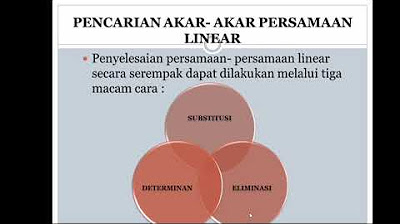Discrete Mathematics Lecture 8 | Domain & Range Of Function | One-One and Onto Function By GP Sir
Summary
TLDRThis educational video focuses on mathematical concepts, specifically the range of functions and solving related equations. The speaker explains how to determine the range, using examples involving absolute values and square roots, while emphasizing constraints for valid solutions. The speaker demonstrates how to solve equations by manipulating variables and provides insights into composite and inverse functions. Viewers are encouraged to comment on the time taken to solve problems and engage with additional content on the speaker’s channel, including further lessons on general aptitude for exams like NET and GATE.
Takeaways
- 😀 The range of a function can be determined by analyzing its square or square root values.
- 😀 When solving for 'A' in a function, certain intervals, such as between -1/2 and 1/2, may restrict the possible values for 'A'.
- 😀 The inverse of a function can be solved algebraically by manipulating the equation to isolate 'X'.
- 😀 Certain values, such as -1, may be excluded from the domain of a function due to undefined expressions like division by zero.
- 😀 The concept of a function’s range is illustrated through an example where the range is confined to the interval [-3, 3] for the variable 'Y'.
- 😀 Negative values in the square root expression require that the expression inside the square root be non-negative for real solutions.
- 😀 Understanding the relationship between variables in equations is key to determining the function’s domain and range.
- 😀 Mathematical functions can be simplified to find solutions, such as solving for 'X' in terms of 'A' in rational equations.
- 😀 The importance of following constraints and bounds (e.g., avoiding division by zero or negative square roots) is emphasized in solving mathematical functions.
- 😀 The tutorial encourages engagement by asking viewers to solve a problem and share solutions in the comments, fostering interaction with the audience.
Q & A
What is the main focus of the video transcript?
-The video primarily focuses on explaining the concept of determining the range of a mathematical function and solving related problems, particularly involving compositions of functions and their inverses.
What mathematical concept is discussed in the first part of the transcript?
-The first part of the transcript discusses the concept of the range of a function, specifically for an equation of the form A = x / (1 - x), and how to find the valid range for values of A.
How is the range of the function A = x / (1 - x) determined?
-The range of the function A = x / (1 - x) is determined by analyzing the behavior of the function and ensuring that the values of A remain within a specific range, excluding values like -1 that would make the function undefined.
What is the value range for A based on the function A = x / (1 - x)?
-The value of A must lie within the range -1/2 to 1/2. If A falls within this range, the function is valid and exists for real numbers.
What happens when the value of A is outside the range -1/2 to 1/2?
-When A falls outside the range -1/2 to 1/2, the function becomes invalid for real numbers, leading to a situation where the function does not have any real solutions.
How do you solve for x in the equation A = x / (1 - x)?
-To solve for x, you manipulate the equation by isolating x on one side. First, multiply both sides of the equation by (1 - x), then rearrange the terms to solve for x, resulting in the expression x = A / (1 + A).
What is the importance of excluding certain values for A in this context?
-Excluding certain values, such as -1, ensures that the function remains valid and does not lead to undefined or complex results, maintaining the consistency of the function within the realm of real numbers.
Can the value of A ever equal -1 for this function?
-No, the value of A cannot equal -1 for this function because it leads to a division by zero, which is undefined in real numbers.
What other examples are mentioned in the transcript to explain the concept of ranges?
-The transcript mentions an example where the function involves a square, and the condition that the square must be positive (greater than zero) is used to find the valid range for another variable, y.
What does the speaker suggest about the solution to the example question?
-The speaker suggests that the solution to the example question will involve solving for a range where the values of A must lie between -3 and 3, which ensures that the function remains valid.
Outlines

Cette section est réservée aux utilisateurs payants. Améliorez votre compte pour accéder à cette section.
Améliorer maintenantMindmap

Cette section est réservée aux utilisateurs payants. Améliorez votre compte pour accéder à cette section.
Améliorer maintenantKeywords

Cette section est réservée aux utilisateurs payants. Améliorez votre compte pour accéder à cette section.
Améliorer maintenantHighlights

Cette section est réservée aux utilisateurs payants. Améliorez votre compte pour accéder à cette section.
Améliorer maintenantTranscripts

Cette section est réservée aux utilisateurs payants. Améliorez votre compte pour accéder à cette section.
Améliorer maintenantVoir Plus de Vidéos Connexes

Integration by Partial Fractions Part 1 (Tagalog /Filipino Math)

Exponential Functions, Equations & Inequalities

Persamaan Garis Singgung dan Garis Normal Fungsi Trigonometri - Aplikasi Turunan Fungsi Trigonometri

Functions and Graphs | Precalculus

5 MTK EKO PENCARIAN AKAR AKAR PERS LINEAR

Osculating Plane | Curve in Space|Unit-1 (lect-8) | Differential Geometry | M.Sc previous Maths
5.0 / 5 (0 votes)
